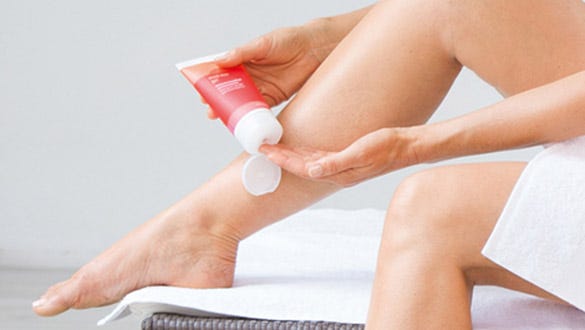- Free First Class Delivery
- Buyer Protection
- Secure Online Shopping
- Healthcare Professional? Click here
The skin


Categories
The skin: multifunction organ with demands
Our skin covers an area of about 1.5 to 2 square metres depending on how big we are. It weighs around 3.5 to 10 kilograms. It is the largest human organ.
But not only these facts are impressive, the list of the skin's tasks is long too: as a sensory organ, it provides us with important information about cold and heat, touch or pain. Its protective function safeguards us against external influences such as germs, mechanical injuries or UV radiation. Furthermore, it is a reservoir for nutrients and water. It excretes waste products in the sweat and, as a positive incidental consequence, also regulates body temperature. How does it do all this? A look inside reveals its anatomy and its remarkable function.
Effective three layer coverage
The skin consists of three layers. Each layer fulfils its very own special tasks.
Epidermis
The outermost layer is the epidermis. This surrounds the human body like a protective shield and is in direct contact with the environment. Its main task is defence against harmful external influences such as germs. At 0.1 millimetres thick, the epidermis is about as thick as a sheet of paper. However, it can be up to five millimetres thick in those places that are exposed to the most wear and tear. These parts of the body include the palms of the hands and the soles of the feet. The outermost surface of the skin is covered with hard, dead cells called keratin. The cells are "glued" firmly together to provide highly resistant protection against mechanical and chemical irritation. Over time, they fall off as skin scales and are replaced by the underlying, newly formed cells. A human loses about 10 g of skin scales every day. The uppermost layer of skin is replaced completely after about four weeks.
Dermis
The dermis lies under the epidermis. It is considerably thicker than the epidermis, very robust and filled with elastic connective tissue, which makes the skin firm, but at the same time elastic. This layer houses the blood vessels, which supply the epidermis with nutrients, as well as sweat glands and lymphatic vessels. The dermis is also home to nerve fibres with special end organs for sensing pressure, touch, pain, temperature and itching.
Subcutis
The third skin layer is the subcutis. This consists mainly of adipose tissue that is divided into individual fat lobes by bands of connective tissue. The high proportion of fat cells serves as protection against the cold and as an energy storage reservoir. This is also where the larger blood vessels and thicker nerve fibres run. Lastly, there are many hair roots and sebaceous and sweat glands.
The protective shield under constant stress
Healthy skin is elastic, smooth and hard-wearing. As the saying goes, we feel comfortable in our own skin. But many factors stress our largest organ. In winter, it’s the combination of the cold outdoors and the dry heated air indoors, while in summer, it's the extensive sunbathing. Direct skin contact with aggressive cleaning agents or frequent showers are a burden on the skin. This stops the skin binding sufficient moisture and oils. The skin grows dry, is tight and feels like parchment. The barrier function also suffers and the skin easily falls prey to damaging influences. It needs our support to retain its full functionality.
How to keep your skin smooth and healthy
What help is there for dry skin? The right care! This starts with daily washing. Ideally, showers should be short and not too hot. Mild shower gels or oils are suitable as a body wash. And even if you find it difficult: long soothing soaks in the tub are not a good idea, as they leach the skin out too much. After cleansing the skin, it is best to care for your face and body with a lotion or cream. The care products should be suited to the individual skin type. We differentiate here between normal, oily, dry to very dry and sensitive skin.
Rich moisturising products are recommended for dry skin. Here, age plays a role too, because the skin grows thinner and thinner over the years. The sebaceous glands and the outer layer no longer work as efficiently and the skin dries out. Besides the right skin care, your diet can also influence the condition of your skin – both positively and negatively. Since the skin requires plenty of nutrients, a poor complexion can be a sign of dietary deficiency. So the same generally applies to the skin as to the whole body: a varied and balanced diet is very important. This includes plenty of fruit and vegetables, milk and wholemeal products, fish and little meat. Extra tip: drink plenty of fluids! By drinking enough water, we help our skin fill its fluid storage reservoir. You should drink about one and a half to two litres a day. And finally, regular physical exercise, plenty of sleep and little stress promote a healthy complexion.
Skin care products from medi
Since patients with venous disease and oedema often have sensitive skin, medi offers a special care range, which is also suitable for very sensitive skin. The high quality ingredients are matched to the needs of patients with venous and oedematous disorders, who wear compression stockings. The soothing care for the skin and the feet pampers the skin, refreshes it and supplies it with moisture. Positive side-effect: damage to the stockings by dry or cracked skin can be avoided. The daytime care gel refreshes the skin and the night-time care helps the skin regenerate. Then there is a cooling spray for in between times that can be sprayed directly onto the medi stocking.









